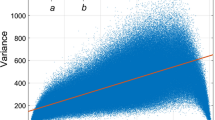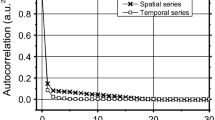Abstract
Purpose
Fluoroscopy is an invaluable tool in various medical practices such as catheterization or image-guided surgery. Patient’s screen for prolonged time requires substantial reduction in X-ray exposure: The limited number of photons generates relevant quantum noise. Denoising is essential to enhance fluoroscopic image quality and can be considerably improved by considering the peculiar noise characteristics. This study presents analytical models of fluoroscopic noise to express the variance of noise as a function of gray level, a practical method to estimate the parameters of the models and a possible application to improve the performance of noise filtering.
Methods
Quantum noise is modeled as a Poisson distribution and results strongly signal-dependent. However, fluoroscopic devices generally apply gray-level transformations (i.e., logarithmic-mapping, gamma-correction) for image enhancement. The resulting statistical transformations of the noise were analytically derived. In addition, a characterization of the statistics of noise for fluoroscopic image differences was offered by resorting to Skellam distribution. Real fluoroscopic sequences of a simple step-phantom were acquired by a conventional fluoroscopic device and were utilized as actual noise measurements to compare with. An adaptive spatio-temporal filter based on the local conditional average of similar pixels has been proposed. The gray-level differences between the local pixel and the neighboring pixels have been assumed as measure of similarity. Filter performance was evaluated by using real fluoroscopic images of a step phantom and acquired during a pacemaker implantation.
Results
The comparison between experimental data and the analytical derivation of the relationship between noise variance and mean pixel intensity (noise-parameter models) were presented relatively to raw-images, after applying logarithmic-mapping or gamma-correction and for difference images. Results have confirmed a great agreement (adjusted R-squared values > 0.8). Clipping effects of real sensors were also addressed. A fine image restoration has been obtained by using a conditioned spatio-temporal average filter based on the noise statistics previously estimated.
Discussion
Fluoroscopic noise modeling is useful to design effective procedures for noise estimation and image filtering. In particular, filter performance analysis has showed that the knowledge of the noise model and the accurate estimate of noise characteristics can significantly improve the image restoration, especially for edge preserving. Fluoroscopic image enhancement can support further X-ray exposure reduction, medical image analysis and automated object identification (i.e., surgery tools, anatomical structures).
Similar content being viewed by others
References
Wang J, Blackburn TJ (2000) The AAPM/RSNA physics tutorial for residents: X-ray image intensifiers for fluoroscopy. Radiographics 20(5): 1471–1477
Tapiovaara MJ (1993) SNR and noise measurements for medical imaging: II. Application to fluoroscopic X-ray equipment. Phys Med Biol 38: 1761–1788
Lo CM, Sawchuk AA (1979) Nonlinear restoration of filtered images with Poisson noise. In: Applications of digital image processing III, proceedings of the seminar, San Diego, California, USA, SPIE Proceedings, pp 84–95
Harrison RM, Kotre CJ (1986) Noise and threshold contrast characteristics of a digital fluoroscopic system. Phys Med Biol 31: 512–586
Chan CL, Katsaggelos AK, Sahakian AV (1993) Image sequence filtering in quantum-limited noise with applications to low-dose fluoroscopy. IEEE Trans Med Imag 12(3): 610–621
Hensel M, Pralow T, Grigat AV (2007) Modeling and real-time estimation of signal-dependent noise in quantum-limited imaging. In: Proceedings of the 6th WSEAS international conference on signal processing, robotics and automation, Corfu Island, Greece, ACM Proceedings, pp 183–191
Cerciello T, Bifulco P, Cesarelli M, Paura L, Pasquariello G, Allen R (2010) Noise reduction in fluoroscopic image sequences for joint kinematics analysis. In: Proceedings of the 22nd mediterranean conference on medical and biological engineering and computing, Springer IFMBE Proceedings, vol 29, pp 323–326
Cerciello T, Romano M, Bifulco P, Cesarelli M, Allen R (2011) Advanced template matching method for estimation of intervertebral kinematics of lumbar spine. Med Eng Phys 33(10): 1293–1302
Cerciello T, Cesarelli M, Paura L, Bifulco P, Romano M, Allen R (2011) Noise-parameter modeling and estimation for X-ray fluoroscopy. In: Proceeding of the 4th international symposium on applied sciences in biomedical and communication technologies, Barcelona, Spain, ACM Proceedings, pp 1–5
Gonzalez RC, Woods RE (1992) Digital image processing, 3rd edn. Addison-Wesley, Reading, Massachusetts
Rodrigues I, Sanches J, Bioucas-Dias J (2008) Denoising of medical images corrupted by Poisson noise. In: Proceedings of the 15th IEEE international conference on image processing, San Diego, California, USA, IEEE Proceedings, pp 1756–1759
Skellam JG (1946) The frequency distribution of the difference between two poisson variates belonging to different populations. J R Stat Soc Ser A 109(3): 296
Bifulco P, Cesarelli M, Allen R, Sansone M, Bracale M (2001) Automatic recognition of vertebral landmarks in fluoroscopic sequences for analysis of intervertebral kinematics. J Med Biol Eng Comput 39(1): 65–75
Bifulco P, Sansone M, Cesarelli M, Allen R, Bracale M (2002) Estimation of out-of-plane vertebra rotations on radiographic projections using CT data: a simulation study. Med Eng Phys 24(4): 295–300
Hwang Y, Kim JS, Kweon IS (2007) Sensor noise modeling using the Skellam distribution: application to the color edge detection. In: Proceedings of the IEEE conference on computer vision and pattern recognition, Minneapolis, MN, USA, IEEE proceedings, pp 1–8
Hirakawa K, Wolfe PJ (2009) Efficient multivariate Skellam shrinkage for denoising photon-limited image data: an empirical bayes approach In: Proceedings of the 16th IEEE international conference on image processing, Cairo, Egypt, IEEE proceedings, pp 2961–2964
Baek YM, Kim JG, Cho DC, Lee JA, Kim WY (2009) Integrated noise modeling for image sensor using Bayer domain images. Lect Notes Comput Sci 5496: 413–424
Bifulco P, Cesarelli M, Allen R, Romano M, Fratini A, Pasquariello G (2010) 2D-3D registration of CT Vertebra volume to fluoroscopy projection: a calibration model assessment. EURASIP J Adv Signal Process 10: 1–8
Hubbard WM (1970) The approximation of a poisson distribution by a Gaussian distribution. Proc IEEE 58(9): 1374–1375
Siewerdsen JH, Cunningham IA, Jaffray DA (2002) A framework for noise-power spectrum analysis of multidimensional images. Med Phys 29(11): 2655–2671
Author information
Authors and Affiliations
Corresponding author
Rights and permissions
About this article
Cite this article
Cesarelli, M., Bifulco, P., Cerciello, T. et al. X-ray fluoroscopy noise modeling for filter design. Int J CARS 8, 269–278 (2013). https://doi.org/10.1007/s11548-012-0772-8
Received:
Accepted:
Published:
Issue Date:
DOI: https://doi.org/10.1007/s11548-012-0772-8




